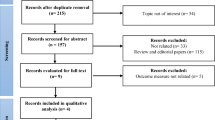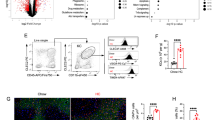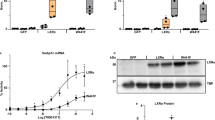Abstract
‘Triton WR 1339’ is known to cause a marked rise of the lipæmia and cholesterolæmia when injected into experimental animals1. It has been suggested that the mechanism responsible for the enhancement of the cholesterol-level of the blood is an increased synthesis of cholesterol, chiefly in the liver2, combined with an alteration in the exchange of cholesterol between the blood and the different organs. This results in a high cholesterolæmia, with normal or even lowered cholesterol-levels in the organs3.
This is a preview of subscription content, access via your institution
Access options
Subscribe to this journal
Receive 51 print issues and online access
$199.00 per year
only $3.90 per issue
Buy this article
- Purchase on SpringerLink
- Instant access to full article PDF
Prices may be subject to local taxes which are calculated during checkout
Similar content being viewed by others
References
Kellner, A., et al., J. Exp. Med., 93, 373 (1951).
Franz, I., and Hinkelman, B., J. Exp. Med., 101, 225 (1955).
Hirsch, R., and Kellner, A., J. Exp. Med., 104, 1 and 15 (1956). Friedman, M., and Byers, S., J. Exp. Med., 97, 117 (1953).
Boyle, A., et al., Symposium on Arteriosclerosis (Benno Schwabe and Co., Verlag, Basle, Stuttgart, 1956).
Author information
Authors and Affiliations
Rights and permissions
About this article
Cite this article
DE SOMER, P., VAN DEN BOSCH, J. & JOOSSENS, J. Surface Tension of the Blood and Atherogenesis. Nature 182, 59 (1958). https://doi.org/10.1038/182059a0
Issue date:
DOI: https://doi.org/10.1038/182059a0



